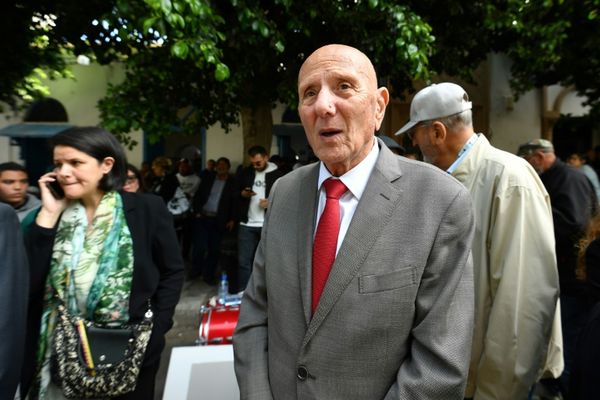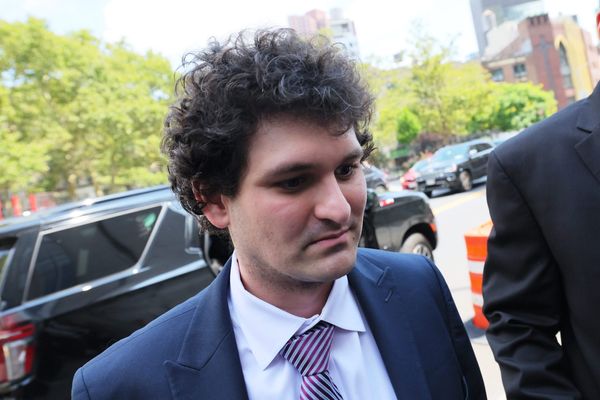
Madonna initially pitched her career-spanning Celebration tour as pop’s most infamous boundary-pusher finally surrendering to nostalgia. “I am excited to explore as many songs as possible in hopes to give my fans the show they have been waiting for,” she said in a statement that didn’t exactly abound with excitement. But, by the time she mounted the first dates in London this month, three months delayed by a bacterial infection that nearly killed her, the show had taken on a different hue: less what fans have been waiting for than what they almost lost.
Conceived prior to her illness, the Celebration tour was already pitched as a memorial, hymning a grimy 70s NYC downtown subsumed by gentrification, the generation of artists lost to Aids, Madonna’s late MTV-era icons Prince and Michael Jackson, and her own mother, who died of breast cancer when she was five years old. No matter how many dancers flanked Madonna on stage, the 65-year-old star cut an implicitly lonely figure – the last of a dying breed. But knowing how precariously she stood at the centre of this spectacle, re-enacting her past almost as if it were a mythological trial, heightened the stakes. What did she have to prove? You could divide the show into two parts: how history shaped Madonna, from the Paradise Garage to photographer Peter Hujar, then how Madonna shaped history, becoming the forcefield into which others were drawn. You could divide it into Madonna the daughter and Madonna the mother – to her literal children, four of whom shared the stage with her, to the LGBTQ+ community (as mother) and to the genre of MTV-era spectacle that set the standard for modern pop stardom.
Two of Madonna’s pop daughters are also currently engaged in the business of looking back: Britney Spears, 41, with her long-awaited memoir, The Woman in Me, and Taylor Swift, 33 – who started out in a lineage of Nashville songwriters but grabbed on to Madonna’s comet tail when she became a fully fledged pop star a decade ago – with her Eras tour and album rerecording project. They are arguably America’s three most archetypal, default pop stars – blond, white, athletic; sonically, aesthetically and morally malleable; vectors of desire and projection – and represent the evolution of the figure over the last four decades, each reverberating with their predecessor’s influence. These are era-defining artists, avatars for the story that culture tells about itself at any particular time. What does it say that three generations of pop’s primary archetype – whose currency is, to some degree, being current – are looking back to redress those definitions?
If Madonna incarnated true power, sexuality and creativity, label executives took the superficial impression of those qualities to create the image of Spears – but crucially denied her the agency to control them herself and overpower the machine behind her. (Spears realises the gulf between them when Madonna stops the shoot for the video for their 2003 collaboration Me Against the Music to get her outfit mended: “I didn’t even know taking so much time for myself was an option … she demanded power and so she got power.”) Swift, born, lest we forget, in 1989, grew up in the disgusting tabloid culture that shamed Spears. The career-obsessed teen doubtless learned from her as a cautionary tale, just as she took her formative apolitical stance from the (Dixie) Chicks’s shunning after they criticised George W Bush during the Iraq war. She never let her sexuality become a focal point that could be used to undermine her (although she would still be belittled for her dating life) and understood that writing her own material gave her ownership over her artistic identity and the direct emotional connection it created with fans.

For all three, seizing the narrative wrests control back from patriarchal forces that have sought to distort it. At 65, Madonna gets to assert her primacy and sexuality, defying ageist and misogynist critics and an industry that bakes in obsolescence to inhibit individual stars’ power and ensure a fresh stream of product. (The Celebration tour also generously foregrounds the queer community that shaped her: doing so at a time when LGBTQ+ rights are under threat makes unmistakable the debt owed to queer culture.) Spears, most urgently, is finally claiming ownership over a life bound by the prurient yet squeamish contradictions of capitalist American pop culture and the trap it laid for her father to confine her in a conservatorship for 13 years. Swift, in a business sense, is also taking back her voice after the master recordings of her first six albums were sold to a male music executive without her being offered the same opportunity to buy them. To devalue the investment, she is rerecording note-for-note copies of the originals to give her control over their use. The accompanying Eras tour, shifting between 17 years of changing musical and aesthetic styles and making stadiums feel intimate, is clear that Swift is the lone axis on which all this pivots.
All three are telling my story, my way – but they’re able to do so now because of shifting social and market forces that primed culture to relitigate those stories. #MeToo opened the floodgates for famous women to re-establish limited public personas shaped by entertainment executives and the media – a system in which all three thrived commercially, if not spiritually – and in doing so made confronting past traumas into a lucrative commodity. Spears’s experience reveals the best and worst of that state of affairs: the New York Times’s 2021 documentary about her conservatorship, Framing Britney Spears, genuinely moved the needle on public perceptions of the embattled star and paved the way for her to be freed from the prohibitive arrangement later that year. But in its wake followed several tawdry, superficial films cashing in on the tragedy. (She seemed to care for neither: “There was so much guessing about what I must have thought or felt,” Spears writes of these productions.) Unpicking the misogynist 2000s tabloid culture that shamed Spears contributed to a new level of media literacy that allowed younger generations to reject the narratives they inherited: hag Madonna, fuck-up Britney, slut Taylor. Those sympathies allowed Swift to present her rerecording project – and fans’ support of it – as a feminist, moral act, as well as a conditional education in music rights.
They have also inarguably been able to achieve these shifts in perception because, as white celebrities, they benefit from far greater re-interpretive leeway than their Black peers, most of whom remain focused on innovation rather than retrospectives: Beyoncé’s contemporaneous Renaissance album and tour only looked back to give Black, queer culture its due, part of her ongoing project to re-establish Black cultural legacies.

A cynic might add that Swift’s rerecording project came about at an apposite time. In the streaming era – which, improbable as it seems to remember now, she eschewed from 2014 to 2017 – new albums seldom have the same impact or payoff as back catalogue (although Swift is one of the only pop stars who skirts that rule), and the project introduces her back catalogue to an ever-rejuvenating fanbase. Any legitimate opportunity to introduce an ever-rejuvenating fanbase to your back catalogue isn’t one any smart artist would pass up. (Last week, Bloomberg reported that Swift is now a billionaire.) In order to introduce her own songs to a new generation, Madonna opted to tour rather than sell her catalogue to an investment fund, as many artists of her generation have done (“ownership is everything, isn’t it?” she told Variety), although her plans to tell her story in a biopic were scuppered. Spears doesn’t seem so actively engaged in regenerating her catalogue: she concludes her memoir by writing that her focus isn’t currently on her music career, and she gained a relatively modest 662k global Spotify listeners in the week of publication. (However her label, RCA, certainly appear to have capitalised on the interest by reissuing nine of her albums on coloured vinyl this year as well as a new digital remix EP of songs from the soundtrack to Crossroads, which was briefly back in cinemas last week.)
Framing the big picture of their work also allows them to stress the context behind their music in an increasingly ahistorical, social media-led fan culture that reduces specific cultural flashpoints to vibes (or indeed eras, language Swift has knowingly repurposed). Though looking back plays into that too: the future has never seemed less certain, and so nostalgia offers a safe haven – even Spears’s harrowing account offers reassurance that, yes, the 2000s were an awful time to be a girl. But what does cultivating your legacy mean for your artistic future? The premium on youth and beauty already traps women in their pasts, as Madonna well knows, and makes it an uphill struggle to have your evolution accepted beyond a certain point. As triumphant as the Celebration tour is, it also represents Madonna accepting that she has crossed the Rubicon into the heritage industry, possibly even admitting defeat on her active artistic currency – her album sales have been on a precipitous decline since 2005’s Confessions on a Dancefloor and the tour setlist features only one song released since then, 2015’s Bitch I’m Madonna. Perhaps she’s accepting the limits of her physicality, too: “I must tell you, I don’t feel very well right now,” she told a crowd in Antwerp. “But I can’t complain because I’m alive.”
Beyond the monetary spoils of reliving her past, hindsight has brought Swift moral vindication: the exploitative power dynamics of formative relationships now transparently evident; even clumsily trying to rectify her internalised teenage misogyny by defanging her slut-shaming rager Better Than Revenge, from the rerecording of her 2010 album Speak Now, with new, softer lyrics. But arguably, cycling back and forth between her adult and younger self has affected her current output: her last original album, 2022’s Midnights, was a nostalgic reflection on “13 sleepless nights” from throughout her life, coupled with an atmospheric, ruminative sound. Her previous albums all boldly staked out new ground – even 2020’s folksy Folklore and Evermore went somewhere new by going back to the land – but this felt like her first consolidation effort.

Alongside those muted lockdown albums, Midnights might have suggested Swift pulling back from pop’s pyrotechnic mountaintop for a more sustainable, experimental, adult kind of music career – were it not for her subsequent (literally) seismic current tour, one of the biggest pop spectacles ever mounted. But it, too, feels as though it is the end of an era in pop superstardom, one that Madonna set in motion 40 years ago: there has been a downturn in the minting of Swift’s successors, with no significant pop breakthroughs since Olivia Rodrigo in 2021. Swift is one of the last monocultural stars, and she operates as one, in conversation with only herself and her legions of fans. Last week, she successfully pushed a four-year-old song (and not a rerecording) to No 1 in the US. The (on-and-off) 19-month Eras tour concludes in November 2024. It’s a long time to perform supremacy via nostalgia.
No one understands that tending your past means stealing from your future like Spears does. In the latter half of the conservatorship – which lasted one-third of her lifetime – she was contractually bound to endure her greatest successes in a five-year Las Vegas residency. Unable to escape, she started to give lacklustre performances on purpose “to punish the people who held me captive”, she writes. “Toning down my energy on stage was my version of a factory shutdown.” In March 2020, Spears posted a quote by the philosopher Mimi Zhu to Instagram that advocated for wealth redistribution and striking, prompting gags about Comrade Britney. It was no joke: Spears understood that she was the means of production. Her initial strike was far from successful: she said that she was confined to a punitive rehab facility for two months after protesting a complicated new dance move because she didn’t feel physically capable of it. But her freedom, post-conservatorship, means possibly shutting down the factory for good. “I don’t have to perform for anyone – on stage or off stage,” she writes.
Since the publication of The Woman in Me, Spears has made clear that she is done looking back. She lambasted the media for turning her story’s juiciest revelations into headlines. “Most of the book is from 20 years ago,” she posted on Instagram. “I have moved on and it’s a beautiful clean slate from here !!! I am here to establish it that way for the rest of my entire life !!! Either way that is the last of it and shit happens !!!” While she can’t cauterise the ongoing interest in her past – one that at its most productive might inspire legal changes to the conservatorship system – Spears has made clear that she is establishing a future on her terms, to which we may or may not be privy. She has done no book promotion; Instagram is the only place you can currently see her. There she maintains an unfiltered, instinctive, immediate presence, dancing and posting memes and thoughts at her whim. There is no more rehearsal, only now.







